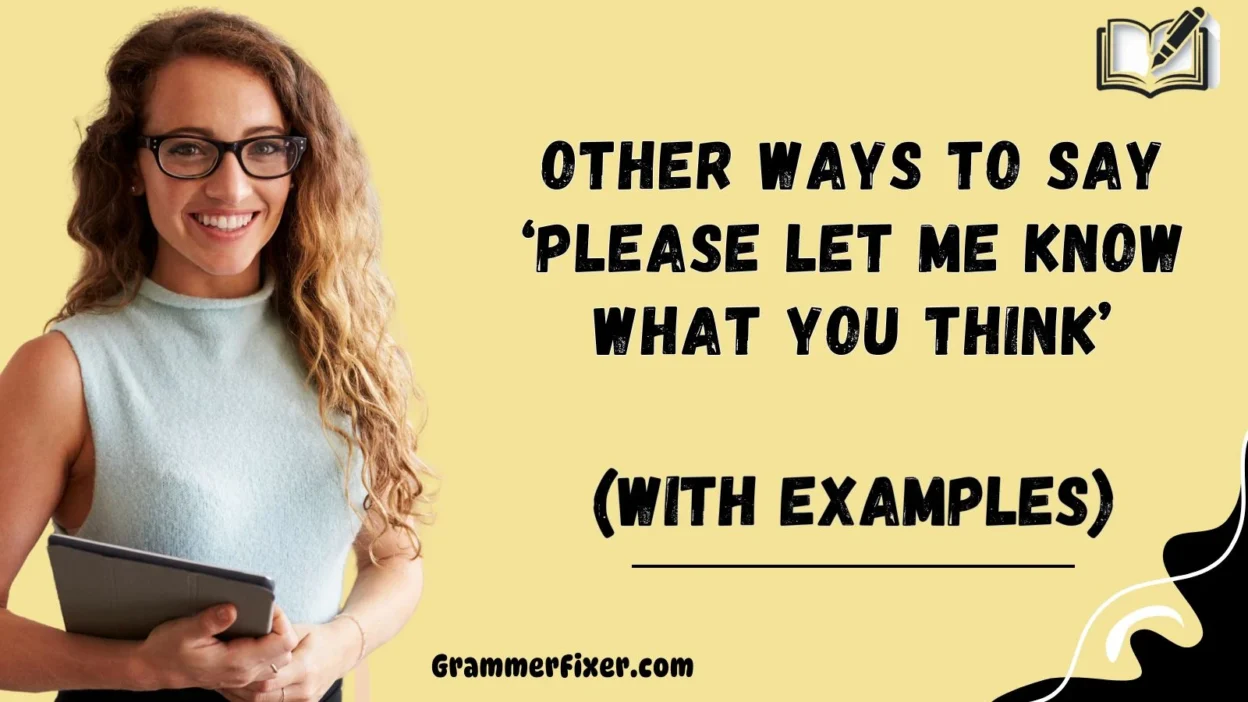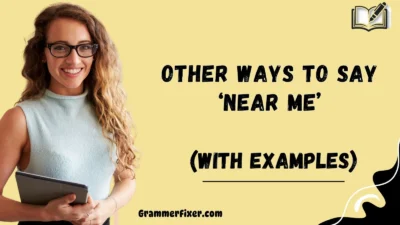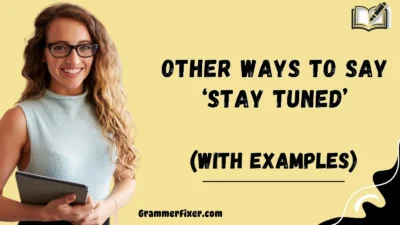Finding the right words to express care, curiosity, or openness is crucial in effective communication. Sometimes, the classic phrase “Please let me know what you think” can feel stale or overused. Exploring alternatives can make your message feel more personal, engaging, and meaningful, helping you foster stronger relationships, encourage honest feedback, and convey genuine interest in someone’s perspective.
Below, we dive into 30 alternative ways to ask for feedback thoughtfully and warmly.
What Does “Please Let Me Know What You Think” Mean?
This phrase is a polite way to request someone’s opinion, thoughts, or feedback on a matter. It shows openness, curiosity, and respect for the other person’s viewpoint. Essentially, it signals that you value their input and are seeking their insights before making a decision or finalizing a project.
When to Use “Please Let Me Know What You Think”?
Use this phrase when you want to:
- Solicit feedback on a document, presentation, or idea.
- Encourage honest opinions in a professional or personal context.
- Demonstrate that you value someone’s perspective and are open to collaboration.
It works well in emails, messages, discussions, and meetings—both formal and informal.
Is It Professional/Polite to Say “Please Let Me Know What You Think”?
Yes, it is generally professional and polite. However, in highly formal settings, it can be replaced with phrases like “I would greatly appreciate your feedback” or “Your insights on this matter would be invaluable” to add weight and respect.
Pros or Cons
Pros:
- Simple, clear, and easy to understand.
- Shows openness and respect.
- Encourages collaboration.
Cons:
- Can feel stale or overused.
- Might not convey enthusiasm or personal touch.
- May sound impersonal in certain creative or high-stakes contexts.
1. I’d love to hear your thoughts
Meaning: Shows genuine interest in someone’s opinion.
Detailed Explanation: Adds warmth and conveys personal engagement. It’s conversational and emphasizes that you value the person’s perspective.
Scenario Example: “I’d love to hear your thoughts on the Q4 social media plan.”
Best Use: Informal or semi-formal emails, team discussions, creative projects.
Worst Use: Highly formal reports or client-facing documents where casual phrasing may appear unprofessional.
Tone: Friendly, warm, approachable
2. Your feedback would be greatly appreciated
Meaning: Requests input politely while acknowledging its importance.
Detailed Explanation: Formal and courteous, ideal for professional settings, client communications, or situations requiring respectful acknowledgment.
Scenario Example: “Your feedback on the website redesign would be greatly appreciated.”
Best Use: Professional emails, client communications, official reviews.
Worst Use: Casual text messages to teammates or peers where it might sound unnecessarily stiff.
Tone: Respectful, professional
3. I’m curious about your perspective
Meaning: Highlights interest in the person’s unique viewpoint.
Detailed Explanation: Encourages honest and thoughtful responses, signaling that you value diverse viewpoints and are open to dialogue.
Scenario Example: “I’m curious about your perspective on the new marketing strategy.”
Best Use: Collaborative projects, brainstorming sessions, discussions with colleagues or peers.
Worst Use: Urgent emails where directness is required; may slow decision-making if overused.
Tone: Engaging, inviting, considerate
4. Any thoughts on this would be welcome
Meaning: Opens the floor for input in a non-demanding way.
Detailed Explanation: Flexible phrasing, suitable for group settings or casual conversations, creating a welcoming environment for feedback.
Scenario Example: “Any thoughts on this draft would be welcome before our next meeting.”
Best Use: Team collaborations, informal requests, early-stage projects.
Worst Use: Situations needing specific, actionable feedback; may feel vague or noncommittal.
Tone: Neutral, inviting
5. I’d appreciate your input
Meaning: Politely requests someone’s opinion while emphasizing that their feedback is valuable.
Detailed Explanation: Direct and concise, balances professionalism with approachability. Signals respect and interest in the recipient’s insights.
Scenario Example: “I’d appreciate your input on the updated product proposal.”
Best Use: Professional emails, collaborative projects, strategic decisions.
Worst Use: Casual conversations where it may sound unnecessarily formal or distant.
Tone: Polite, professional, considerate
6. I’d be grateful for your thoughts
Meaning: Requests input while expressing gratitude in advance.
Detailed Explanation: Conveys warmth and respect, showing that you value the recipient’s perspective. It is slightly more personal than standard requests.
Scenario Example: “I’d be grateful for your thoughts on the Q2 project plan.”
Best Use: Semi-formal emails, collaborative projects, mentorship contexts.
Worst Use: Casual chat with close colleagues; may feel overly formal.
Tone: Warm, courteous, respectful
7. Your insights would be invaluable
Meaning: Emphasizes that the person’s opinion is highly important and influential.
Detailed Explanation: Suitable for professional contexts where expertise or experience matters. Shows acknowledgment of skill or knowledge.
Scenario Example: “Your insights on this marketing strategy would be invaluable for our next steps.”
Best Use: Executive reviews, client feedback, research discussions.
Worst Use: Informal or casual contexts; may sound exaggerated or intimidating.
Tone: Professional, appreciative, serious
8. I’d like your take on this
Meaning: Requests someone’s perspective or viewpoint on a matter.
Detailed Explanation: Casual yet professional; signals that you are open to different opinions. Suitable for quick feedback or peer collaboration.
Scenario Example: “I’d like your take on the new product feature draft.”
Best Use: Team meetings, peer feedback, project discussions.
Worst Use: Highly formal emails or client-facing communications; may appear too casual.
Tone: Neutral, approachable, flexible
9. I welcome your suggestions
Meaning: Invites ideas or improvements openly and politely.
Detailed Explanation: Encourages creative input and shows you are receptive to different options. Works well in both professional and casual settings.
Scenario Example: “I welcome your suggestions on how we can improve the user interface.”
Best Use: Team brainstorming sessions, project reviews, design discussions.
Worst Use: Urgent decisions requiring immediate action; may slow down response if overused.
Tone: Open, encouraging, collaborative
10. Could you share your viewpoint?
Meaning: Polite request for someone’s opinion or perspective.
Detailed Explanation: Slightly formal; emphasizes respect and professional courtesy. Works well in structured discussions or formal emails.
Scenario Example: “Could you share your viewpoint on the proposed policy changes?”
Best Use: Professional emails, meetings, advisory contexts.
Worst Use: Casual chat with friends or informal team interactions; may feel stiff.
Tone: Courteous, professional, respectful
11. I’m eager to hear your opinion
Meaning: Shows enthusiasm and genuine interest in someone’s feedback.
Detailed Explanation: Demonstrates positive anticipation and encourages active participation. Works well when input is highly valued.
Scenario Example: “I’m eager to hear your opinion on the draft report before the client meeting.”
Best Use: Collaborative projects, presentations, creative work.
Worst Use: Situations where neutrality is needed; may seem too informal in formal documentation.
Tone: Warm, enthusiastic, engaging
12. Your thoughts on this would be appreciated
Meaning: Requests feedback politely and professionally.
Detailed Explanation: Balances formal and approachable language, signaling that the recipient’s input is valuable and considered.
Scenario Example: “Your thoughts on this proposal would be appreciated before we proceed.”
Best Use: Professional emails, client or team reviews.
Worst Use: Informal chat; may sound repetitive or overly formal.
Tone: Polite, professional, neutral
13. Please share your ideas
Meaning: Invites creative or constructive input in a clear, friendly way.
Detailed Explanation: Straightforward and actionable; encourages participation without pressure.
Scenario Example: “Please share your ideas for improving the customer experience.”
Best Use: Team discussions, brainstorming sessions, workshops.
Worst Use: Highly formal reports or executive communications; may feel too casual.
Tone: Friendly, approachable, collaborative
14. I’d like to get your feedback
Meaning: Requests input explicitly while showing respect for the recipient’s opinion.
Detailed Explanation: Neutral and professional; suitable for both internal and external communication.
Scenario Example: “I’d like to get your feedback on the revised marketing plan.”
Best Use: Project updates, client emails, peer reviews.
Worst Use: Urgent requests needing immediate answers; may delay action if overused.
Tone: Professional, considerate, neutral
15. Any input you could provide would be helpful
Meaning: Politely asks for feedback while emphasizing that it would assist decision-making.
Detailed Explanation: A slightly formal phrase that signals openness to suggestions. Good for situations requiring careful consideration.
Scenario Example: “Any input you could provide would be helpful in finalizing the proposal.”
Best Use: Professional emails, project planning, decision-making meetings.
Worst Use: Casual chats; may feel too wordy or stiff.
Tone: Polite, professional, collaborative
16. I’d love your input
Meaning: Requests feedback warmly and personally.
Detailed Explanation: Slightly casual and inviting; signals that the recipient’s opinions and insights are genuinely valued.
Scenario Example: “I’d love your input on the draft presentation slides.”
Best Use: Team collaborations, creative projects, mentorship conversations.
Worst Use: Highly formal emails to executives or clients; may seem too informal.
Tone: Friendly, approachable, warm
17. Your opinion matters to me
Meaning: Highlights the importance of the person’s viewpoint.
Detailed Explanation: Shows respect and acknowledgment; encourages honesty and openness.
Scenario Example: “Your opinion matters to me as we finalize the new product design.”
Best Use: Personal or professional relationships, mentoring, collaborative projects.
Worst Use: Brief transactional emails; may feel overly sentimental in formal reports.
Tone: Considerate, respectful, encouraging
18. I welcome your feedback
Meaning: Invites input in a polite and open manner.
Detailed Explanation: Professional and versatile; signals readiness to accept constructive criticism.
Scenario Example: “I welcome your feedback on the updated client proposal.”
Best Use: Professional reviews, internal communications, client-facing documents.
Worst Use: Casual conversations; may sound unnecessarily formal.
Tone: Professional, respectful, open
19. Please provide your thoughts
Meaning: Direct request for someone’s viewpoint.
Detailed Explanation: Straightforward and professional; emphasizes clarity and actionable feedback.
Scenario Example: “Please provide your thoughts on the revised project timeline.”
Best Use: Professional emails, project updates, collaborative work.
Worst Use: Informal chats; may appear too rigid or transactional.
Tone: Direct, professional, neutral
20. I’d like to know your perspective
Meaning: Seeks the recipient’s unique viewpoint.
Detailed Explanation: Polite and engaging; emphasizes consideration for diverse opinions.
Scenario Example: “I’d like to know your perspective on the new marketing strategy.”
Best Use: Team discussions, brainstorming sessions, professional consultations.
Worst Use: Casual conversations where brevity is preferred; may feel formal.
Tone: Courteous, professional, inviting
21. Your input would be highly valued
Meaning: Signals that the person’s feedback is significant and impactful.
Detailed Explanation: Professional and appreciative; ideal for situations where expertise or experience is important.
Scenario Example: “Your input would be highly valued in shaping the new HR policy.”
Best Use: Executive meetings, strategic planning, research or advisory contexts.
Worst Use: Casual text messages or peer chats; may sound too formal or stiff.
Tone: Respectful, professional, appreciative
22. I’m open to your thoughts
Meaning: Shows receptiveness and flexibility toward feedback.
Detailed Explanation: Neutral and approachable; encourages honest communication without pressure.
Scenario Example: “I’m open to your thoughts on how we can improve workflow efficiency.”
Best Use: Team projects, collaborative discussions, informal professional settings.
Worst Use: Urgent decisions requiring direct answers; may seem noncommittal.
Tone: Open, approachable, collaborative
23. Any ideas you’d like to share?
Meaning: Invites creative suggestions or solutions.
Detailed Explanation: Casual, friendly, and encouraging; stimulates active participation.
Scenario Example: “Any ideas you’d like to share for the upcoming campaign?”
Best Use: Brainstorming sessions, workshops, team meetings.
Worst Use: Formal reports or client communications; may feel too informal.
Tone: Friendly, collaborative, engaging
24. I’d love to get your opinion
Meaning: Requests feedback warmly and personally.
Detailed Explanation: Shows enthusiasm and personal engagement, ideal for situations where the recipient’s view is important.
Scenario Example: “I’d love to get your opinion on the new website layout.”
Best Use: Team collaborations, peer reviews, informal professional conversations.
Worst Use: Highly formal communications; may appear too casual.
Tone: Warm, approachable, encouraging
25. Your thoughts would help me a lot
Meaning: Indicates that the person’s input is valuable for decision-making.
Detailed Explanation: Expresses gratitude and shows that feedback has a direct impact on the process or outcome.
Scenario Example: “Your thoughts would help me a lot in finalizing the product specifications.”
Best Use: Professional collaboration, mentorship, peer review.
Worst Use: Casual interactions; may sound unnecessarily formal or needy.
Tone: Respectful, appreciative, professional
26. I’m seeking your honest opinion
Meaning: Requests straightforward and truthful feedback.
Detailed Explanation: Encourages candor and transparency, signaling that constructive criticism is welcome.
Scenario Example: “I’m seeking your honest opinion on the draft report before submission.”
Best Use: Mentorship, project reviews, performance feedback.
Worst Use: Casual conversations; may feel too heavy or formal for informal settings.
Tone: Serious, respectful, encouraging
27. I’d value your viewpoint
Meaning: Highlights the importance of the recipient’s unique perspective.
Detailed Explanation: Polite and professional; shows respect and consideration for their expertise.
Scenario Example: “I’d value your viewpoint on the upcoming product launch strategy.”
Best Use: Executive or team meetings, strategic planning, advisory discussions.
Worst Use: Informal chats or casual brainstorming; may seem stiff.
Tone: Professional, respectful, appreciative
28. Please weigh in when you can
Meaning: Politely asks someone to contribute their opinion at their convenience.
Detailed Explanation: Non-demanding phrasing; shows respect for the recipient’s time and schedule.
Scenario Example: “Please weigh in when you can on the draft presentation.”
Best Use: Team projects, collaborative emails, low-pressure requests.
Worst Use: Urgent matters requiring immediate feedback; may delay action.
Tone: Courteous, flexible, professional
29. I’m looking forward to your thoughts
Meaning: Expresses anticipation and eagerness for feedback.
Detailed Explanation: Warm and engaging; encourages active participation and conveys genuine interest.
Scenario Example: “I’m looking forward to your thoughts on the Q3 strategy document.”
Best Use: Professional emails, collaborative projects, mentoring or client communications.
Worst Use: Casual chats where immediate action is needed; may sound formal.
Tone: Warm, inviting, professional
30. Your feedback would be appreciated
Meaning: Politely requests feedback while acknowledging its importance.
Detailed Explanation: Simple, direct, and professional; works across a wide range of contexts.
Scenario Example: “Your feedback would be appreciated on the revised user interface design.”
Best Use: Professional emails, client communications, project reviews.
Worst Use: Casual chats; may feel too formal for informal settings.
Tone: Respectful, neutral, professional
Conclusion
Finding the right words to ask for someone’s feedback can make all the difference in how your message is received. Using phrases beyond the classic “Please let me know what you think” allows you to convey warmth, respect, and genuine interest, creating a more meaningful connection with your audience.
Each alternative in this list is designed to help you:
- Express appreciation for someone’s opinions, insights, or perspective.
- Encourage open and honest communication, whether in professional or personal contexts.
- Adapt your tone to suit formal emails, casual team discussions, creative projects, or client communications.
- Foster collaboration by showing that input is valued and has a tangible impact on decisions or outcomes.



